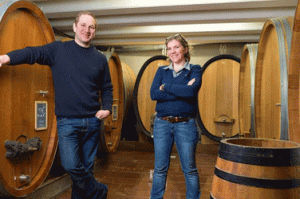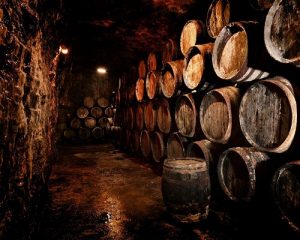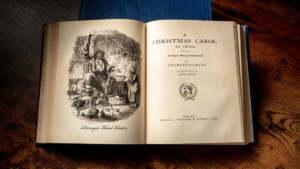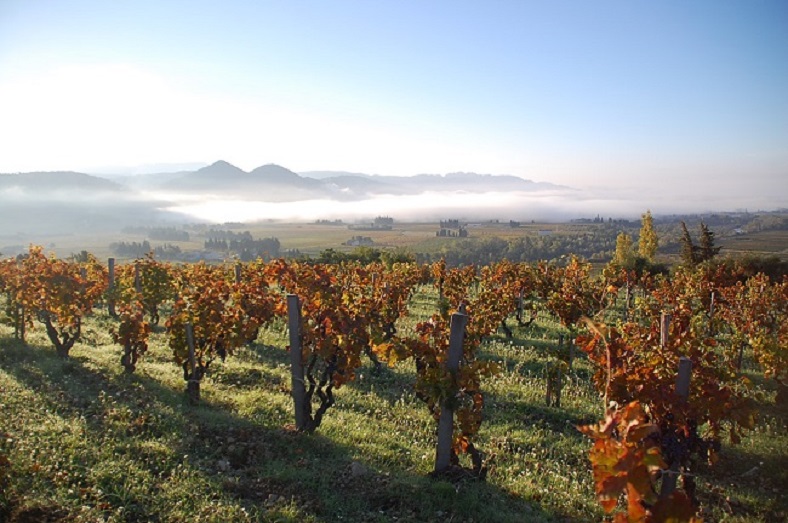
“I love cooking. I make voluptuous wines to be savoured, so they should be served with mellow, mouth-watering dishes. I recommend pairing my whites with chicken and morels, fish dumplings, or white truffle risotto. My red cuvées are perfect for serving with flavourful, noble dishes like beef.” Hearing Jérôme Bressy take about his wines and his love for the kitchen is music to my ears. He manages to tickle the tastebuds, even after a copious meal. Has this little prelude managed to whet your appetite? Well, let’s allow this excellent producer to tell us his story…
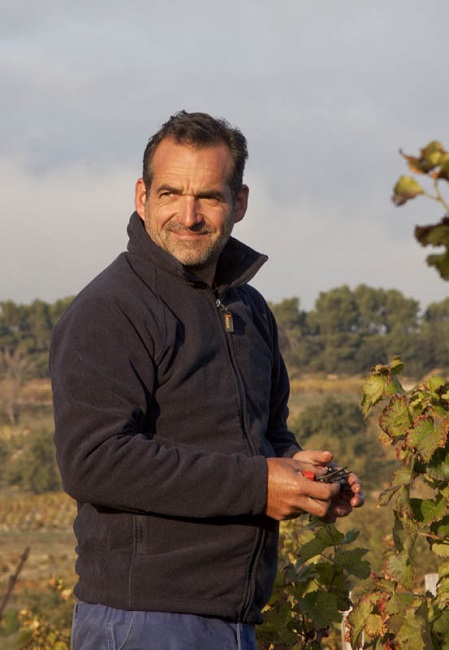 To the question “Why did you choose to leave the cooperative cellar?”, the response comes naturally with a dash of story-telling spirit. “I come from a family of wine makers who, like many in the surrounding area, would sell their grapes to the local cooperative. As a boy, I would follow my father and grandfather in the vineyard, making the wine with them. I really honed a passion for the vigneron vocation and it interested me; I saw it as the full accomplishment of a vine growers work. His holy grail, in a way.
To the question “Why did you choose to leave the cooperative cellar?”, the response comes naturally with a dash of story-telling spirit. “I come from a family of wine makers who, like many in the surrounding area, would sell their grapes to the local cooperative. As a boy, I would follow my father and grandfather in the vineyard, making the wine with them. I really honed a passion for the vigneron vocation and it interested me; I saw it as the full accomplishment of a vine growers work. His holy grail, in a way.
I didn’t pursue my studies, finishing with school at the age of 17 to help my father and learn the traditional ways of Châteauneuf-du-Pape. As the years went by, I still coveted this idea of becoming a wine maker, and I gradually discovered the world of fine wine. This was a more creative world. My ambition was confirmed; I wanted to make a different kind of wine. A wine with a pure expression of the earth. For this, I had to have living soils and made the conversion to organics, a process that I committed to before the age of 20 and whilst I was still dependent on the cooperative cellar.
In this same vein, I discovered biodynamics in 1993. At the time I was a bit avant-garde, enlightened – dare I say – in the eyes of others. After doing my military service, I made a definitive go at wine making, crafting my first vintage in 1996 in a little garage. Of course, my family were concerned to see me leave behind the reassuring constraints of the co-op. But this feeling was quickly replaced by great pride and strong support. After working for two years in this way, I went to the bank to seek an investment for a better vinification system.
My style quickly made an impression upon both enthusiasts and professionals. I didn’t have to wait long for success. This first experience helped me to realise that with passion, I could succeed in spite of difficulties. And the difficulties are what allowed me to question my methods…this is still the case!
Vieux carignan, Counoise, Vaccarèse for the reds; Picardon, Clairette, Grenache for the whites are just a few of your many varietals. Tell me about your idea to rehabilitate these old grapes?
I wanted to preserve the culture of those who came before. I began in 1993 with the Counoise grapes, and since then I’ve carried out complantation experiments every year as I enjoy the richness and nuance this engenders. The process involves tasting different varietals before selecting only the best ones; these I will work with in depth. It’s quite a risky business as I never know for sure what the result will be…But it works! A kind of synergy develops between the plants in time, they ripen together. I hope whoever inherits these diverse vines will make something original with them.
Tell me about your viticultural methods
I work on my 15 hectares of old vines every day. I aim for low yields thanks to the hundred-year-old plants that produce very little. Some of the younger vines make more of a dry extract than a juice. I carry out gobelet pruning, and this combined with the deep roots offer an average volume of between 8 and 15 hectolitres per year.
This year I was hit by a mildew brought about by spring showers. This meant I lost some of the harvest which, along with the fact we harvested late, led to a yield of 3hl/ha overall, of very high quality, though!
When it comes to the harvest, mine can be particularly long and can, as was the case this year, last all the way into early November. As I said, I do take risks to get the best expression of the terroir. I trust my taste of the grapes without overly analysing. If it’s good, I harvest.

How do you organise your team’s work?
I have a little, full-time team of 3 people. I’m involved in every stage of the process; this is important for my personal satisfaction, and I find that if I delegate too much work, I separate myself from my objectives.
Biodynamic methods are what allow me to reach these objectives. The domain is certified, though I don’t put this on the bottle as I don’t want it to be seen as a marketing ploy. The growing of my vines follows the calendar, since each day influences the soil and the plant slightly differently. Inevitably, when the weather’s good, we spend all day outside. When it’s not as nice out, we spend our time preparing orders and other tasks that don’t affect the vines. In any case, there is always something to be done!
In terms of vinification, what’s your signature style?
I don’t have a recipe that I follow to the letter. Sometimes I have a style phase that lasts three to four vintages. I vinify my wines separately, taking the time to find my path. For example, I used to destem the bunches completely, and now I only do it partially.
Generally speaking, though, I don’t use additives and no extra yeast is needed. Same goes for enzymes. I do add a bit of sulphur after the malolactic fermentation, but only a small dose to stabilise the wine.
The wine matures for a long time: two years for the whites and three for the reds. I also age them in the bottle for a while so that they’re already pleasant when I sell them.
Let’s finish with (perhaps) the most important bit: the wine!
My wines are made to be aged at length (around 20 years) and begin to reveal their aromatic palette after 7 years. I recommend decanting the young ones, the others just need to be opened around an hour before serving. Believe me, they’ll speak for themselves, with different expressions throughout the course of a good meal.
Thank you to Jérôme Bressy for giving up some of his precious time for an enriching and lively interview. We wish him the best in his experimental work!
Here are the wines from Domaine Gourt de Mautens currently available at iDealwine

